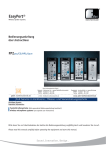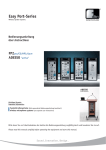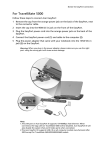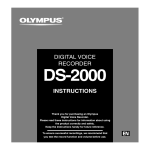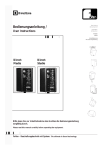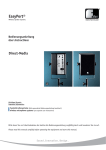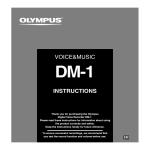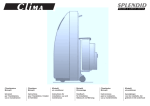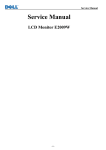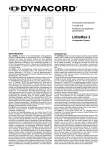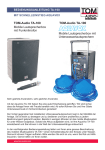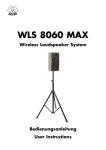Download Infos / Bedienungsanleitung - veranstaltungstechnikmieten.de
Transcript
FP2pro/CD/slave Bedienungsanleitung User Instructions FP2pro FP2CD + - + - 12V 12V 951 511 951 521 FP2slave passiv 951 531 Bitte lesen Sie vor Inbetriebnahme des Gerätes die Bedienungsanleitung sorgfältig durch. Please read this manual carefully before operating the equipment. Fohhn Audio AG Sound.Innovation.Design. 2 Inhalt . . . . . . . . . . . . . . . . . . . . . . . . . . . . . . . . . . . . . . . . . . . . Seite 1. Einleitung . . . . . . . . . . . . . . . . . . . . . . . . . . . . . . . . . . . . . . . . . 3 2. Sicherheit und Umwelt ...............................3 2.1 Sicherheitshinweise . . . . . . . . . . . . . . . . . . . . . . . . . . . . . . 3 2.2 Beeinträchtigung der Sicherheit . . . . . . . . . . . . . . . . . . . . . . 3 2.3 Umwelt . . . . . . . . . . . . . . . . . . . . . . . . . . . . . . . . . . . . . . . 3 3. Lieferumfang . . . . . . . . . . . . . . . . . . . . . . . . . . . . . . . . . . . . . . . 3 4. Beschreibung . . . . . . . . . . . . . . . . . . . . . . . . . . . . . . . . . . . . . . 4 4.1 Allgemeines ...................................4 4.2 Empfohlenes Zubehör ............................4 4.3 Bedienelemente . . . . . . . . . . . . . . . . . . . . . . . . . . . . . . . . . 4 4.3.1 CD Player (nur FP2CD) . . . . . . . . . . . . . . . . . . . . . . . 6 5. Inbetriebnahme . . . . . . . . . . . . . . . . . . . . . . . . . . . . . . . . . . . . . 7 5.1 Betriebsbedingungen . . . . . . . . . . . . . . . . . . . . . . . . . . . . . 7 5.2 Audio-Verbindungen . . . . . . . . . . . . . . . . . . . . . . . . . . . . . . 7 5.3 Einschalten/Betrieb mit Akku . . . . . . . . . . . . . . . . . . . . . . . . 7 5.3.1 Tiefentladeschutz ...........................7 5.4 Einschalten/Betrieb am Netz . . . . . . . . . . . . . . . . . . . . . . . . 8 5.5 Funkmikrofon und Empfänger . . . . . . . . . . . . . . . . . . . . . . . . 8 5.6 Betrieb der FP2pro/CD mit FP2slave . . . . . . . . . . . . . . . . . . . . . 8 6. Betriebshinweise . . . . . . . . . . . . . . . . . . . . . . . . . . . . . . . . . . . . 8 6.1 Aufstellungsort der EasyPort . . . . . . . . . . . . . . . . . . . . . . . . 8 6.2 Vermeidung von akustischen Rückkopplungen ...........8 7. Reinigung . . . . . . . . . . . . . . . . . . . . . . . . . . . . . . . . . . . . . . . . . 8 8. Technische Daten 9. Abbildungen ...................................9 . . . . . . . . . . . . . . . . . . . . . . . . . . . . . . . . . . . . . 18 9.1 Bedienelemente FP2pro . . . . . . . . . . . . . . . . . . . . . . . . . . 18 9.2 Bedienelemente FP2CD . . . . . . . . . . . . . . . . . . . . . . . . . .19 9.3 Bedienelemente FP2slave . . . . . . . . . . . . . . . . . . . . . . . . . 20 Englische Bedienungsanleitung / User Instructions . . . . . . . . . . . . . 10 3 1. Einleitung 2.3 Umwelt Die EasyPort ist ein hochwertiges Beschallungssystem, das die vielfältigen Wünsche der Anwender erfüllt. Im mobilen wie auch im stationären Betrieb sind Beschallungen mit minimalem Zeitaufwand realisierbar. Das professionelle Konzept ist durch seine leichte Bedienbarkeit auch für den Laien ohne besondere Vorkenntnisse nutzbar. Die praxisgerechten Bedienelemente und das robuste Gehäuse unterstützen den Anwender bei jedem Einsatzzweck. 1. Entsorgen Sie verbrauchte Batterien immer gemäß den jeweils geltenden Entsorgungsvorschriften. Werfen Sie Batterien nie ins Feuer (Explosionsgefahr). 2. Wenn Sie das Gerät verschrotten, trennen Sie Gehäuse, Elektronik und Kabel und entsorgen Sie alle Komponenten gemäß den dafür geltenden Entsorgungsvorschriften. 2. Sicherheit und Umwelt 3. Lieferumfang 2.1 Sicherheitshinweise Ihre EasyPort FP2pro besteht aus folgenden Komponenten: 1. 2. 3. Dieses Gerät ist gemäß den VDE-Schutzmaßnahmen für elektronische Geräte gebaut und geprüft. Es hat das Werk in sicherheitstechnisch einwandfreiem Zustand verlassen. Um diesen Zustand zu erhalten und einen gefahrlosen Betrieb sicherzustellen, beachten Sie bitte sowohl die allgemein üblichen Sicherheitsvorkehrungen als auch die Hinweise und Warnvermerke in dieser Bedienungsanleitung. Das Gerät entspricht den Bestimmungen der Schutzklasse1. In ordnungsgemäß installiertem Zustand sind alle berührbaren Metallteile fest mit dem Schutzleiter verbunden. Aus Sicherheitsgründen darf das Gerät nur an einer vorschriftsmäßigen Schutzkontaktsteckdose betrieben werden. Trennen sie niemals die Schutzkontaktverbindung auf. Das Gerät entspricht den derzeit gültigen Normen des EMVGesetzes. Dies wird durch das am Gerät angebrachte CEZeichen bescheinigt. 4. Das Gerät enthält keine vom Anwender reparierbaren Teile. Zur Vermeidung der Gefahr von Bränden oder elektrischen Schlägen öffnen Sie das Gehäuse nicht und wenden Sie sich für Reparaturen an einen qualifizierten Techniker. 5. Hohe Schalldrücke können Gehörschäden verursachen! Halten Sie sich nie unmittelbar vor einer betriebsbereiten Box auf. Vermeiden Sie Rückkopplungen. 2.2 Beeinträchtigung der Sicherheit Wenn das Gerät • • • • • sichtbare Beschädigungen aufweist, lose Teile enthält, nicht mehr korrekt arbeitet, längere Zeit unter ungünstigen Bedingungen gelagert wurde (z.B. im Freien oder in feuchten Räumen) oder schweren Transportbeanspruchungen ausgesetzt war (z.B. mit einer ungeeigneten Verpackung), kann die Sicherheit beeinträchtigt sein. Setzen Sie das Gerät außer Betrieb und kennzeichnen Sie es. Sichern Sie das Gerät so gegen unbeabsichtigten Betrieb, daß es nicht versehentlich von Dritten wieder in Betrieb genommen werden kann. 1. 2. 3. Aktivbox FP2pro Netzkabel kleiner Schraubendreher (um die gain-Regler einzustellen) Ihre EasyPort FP2CD besteht aus folgenden Komponenten: 1. 2. 3. 4. Aktivbox FP2CD Netzkabel anschraubbare Hochständerhülse kleiner Schraubendreher (um die gain-Regler einzustellen) Ihre EasyPort FP2slave besteht aus folgenden Komponenten: 1. 2. Passivlautsprecher FP2slave Speakonbuchse mit Kabelsatz für den Einbau in die Master-Aktivlautsprecherbox FP2pro/CD (19) Optionale Funkmikrofon Systeme für EasyPort FP2pro/CD 1. 2. Funkempfänger (eingebaut in EasyPort) Handsender mit Mikrofonkopf oder Taschensender mit Ansteckmikrofon bzw. Headset Kontrollieren Sie bitte, ob die Verpackung alle zum jeweiligen System gehörenden Teile enthält. Falls etwas fehlt, wenden Sie sich bitte an Ihren Fohhn-Händler. 4 4. Beschreibung 4.1 Allgemeines FP2pro/CD Die EasyPort FP2pro/CD sind aktive Mono-Lautsprecherboxen. Ein eingebautes Mischpult mit 2-Band-Klangregelung erlaubt Ihnen, einen CD-Spieler oder ähnliche Tonquellen, zwei drahtgebundene Mikrofone sowie das optional mitgelieferte Drahtlos-Mikrofon gleichzeitig zu betreiben. Insgesammt können bis zu 4 Funkempfänger eingebaut werden. Die FP2CD ist mit einem integrierten CD-Player ausgestattet. Die optional eingebauten Empfänger zeichnen sich durch hohe Empfangssicherheit und hervorragende Tonqualität aus. Durch den passenden Hand- bzw. Taschensender wird die EasyPort zu einem kompletten Beschallungssystem für kabel- und drahtlosen Betrieb. Für den netzunabhängigen Betrieb ist die EasyPort mit einem wartungsfreien, auslaufsicheren Bleigel-Akku sehr hoher Qualität ausgestattet, der die strengen Normen des Verbandes der Schadensversicherer (Gefahrenmelde-Anlagen) erfüllt. Der Akku weist eine wesenlich geringere Selbstentladung und ein besseres Kapazitäts/Volumen-Verhältnis als Nickel-CadmiumAkkus auf und hat keinen Memory-Effekt. Die Kapazität beträgt 7,2 Ah bei FP2pro/CD. FP2slave Die EasyPort FP2slave ist ein passiver Zusatzlautsprecher zum Anschluß an eine FP2 pro und FP2 CD (keine eingebaute Elektronik). Die FP2slave wird mittels einem optionalem Lautsprecherkabel (Speakon) mit der aktiven Masterlautsprecherbox FP2pro oder FP2CD verbunden. Die FP2pro und FP2CD sind serienmäßig nicht mit einem Speakon Lautsprecherausgang ausgestattet. Deshalb befindet sich im Lieferumfang eine Speakon Lautsprecherbuchse mit vorbereitetem Kabelsatz für den leichten Einbau in die FP2pro bzw. FP2CD an der die FP2slave betrieben wird. 4.2 Empfohlenes Zubehör FP2pro/CD/slave • Tragetasche für FP2pro/CD/slave, gepolstert • Regenhaube für FP2pro/CD/slave, • Stativgabel SHP2 für FP2pro/CD/slave • Wandhalter WHP2 (Box schwenk- und neigbar) • Wandhalter WHP1 (Box abnehmbar) • Lautsprecherstativ • Mikrofonstativ mit Galgen • Tragetasche für 2x Stative • Music-Tray (Ablage für tragbare Zuspielgeräte) einfache Montage am Lautsprecherstativ 4.3 Bedienelemente (Siehe Seite 18-20) Die meisten Bedienelemente der FP2pro/CD/slave befinden sich an der Rückseite der Lautsprecherbox. Unter der Klappe im Deckel befinden sich die Bedienelemente Squelch (10) und Kanalwahlschalter (11) der optional eingebauten Funkempfängern. An der Hinterseite der EasPort ist ein stabiler Tragegriff angebracht. (1) recharge battery (Batterie aufladen) Ladebuchse zum Aufladen des eingebauten Akkus mit Hilfe des mitgelieferten Netzkabels. Dient auch zum Anschluß bei Netzbetrieb. (18) Netzsicherung (fuse) Die Netzsicherung befindet sich unterhalb der Netzbuchse. Vor dem Wechsel der Sicherung muß die FP2pro/CD vom Stromnetz getrennt werden. Bei 230V Netzspannung darf nur folgende Sicherung verwendet werden: 1 A MTR (5x20mm) (2) Lade-Kontroll-LED Schnelllade Modus, Ladezeit 6h wenn die gelbe LED dauernd leuchtet befindet sich die FP2pro im Schnelllade Modus, anschließend wird auf Ladungserhaltung umgeschaltet und die LED blinkt. (3) power-Schalter (Ein/Aus Schalter) Der power-Schalter schaltet die Audio-Elektronik und den Verstärker der EasyPort, nicht jedoch die Ladeelektronik ein und aus. (4) Status Anzeige Status-LED, mehrfarbig, Ladezustandsanzeige des Akkus wird durch Blinksequenz angezeigt. Wenn die FP2pro eingeschaltet wird leuchtet die LED bei geladenem Akku grün. Wenn die Akku Kapazität 30% unterschreitet, fängt die LED an rot zu blinken. Die LED blinkt bei sinkender Akku Spannung immer schneller rot, bis sie ständig rot leuchtet. Nachdem die LED 10 Sekunden dauer rot geleuchtet hat, schaltet sich die FP2pro/CD ab, um eine Tiefentladung des Akkus zu verhindern. Beim Abschalten ertönt ein Signalton. (20) DC out Buchse (12 Volt Ausgang) DC-out Buchse, 12V 500mA zum Anschluß externer Geräte wie externer Funkempfänger, Zuspielgeräte wie CD-Player usw. Die DC-out Buchse ist kurzschlußfest und hat einen Verpolungsschutz. Hinweis: Die FP2 pro/CD kann durch diese Buchse nicht geladen werden. 5 (19) Lautsprecheranschlußbuchse für FP2slave (Optional) Speakonbuchse für den Anschluß einer FP2slave. Hinweis: Aus Sicherheitsgründen darf an diesem Anschluß nur die dafür abgestimmte Systembox FP2slave betrieben werden! music (Anschluß Zuspielgerät) (5) line input l/r (Musik/Zuspielgerät Eingang l/r) An diese beiden Cinch-Buchsen können Sie über ein StereoCinch-Kabel einen CD-Spieler, Cassettenrecorder oder andere Hochpegelquellen anschließen. Der Eingang ist als Stereo-Eingang ausgelegt, intern wird jedoch eine MonoSumme gebildet. Die Eingangsempfindlichkeit beträgt 100mV an 10kΩ für Vollaussteuerung. (23) line input Line Eingang, XLR elektronisch symmetrisch, für Zuspielgeräte oder andere Signalquellen (Symmetriertrafo optional) (6) volume (Lautstärke) Mit dieser Drehregler stellen Sie die Lautstärke der an die line input-Buchsen (5) + (23) angeschlossenen Tonquellen ein. (15) gain (Vorpegelsteller) Mit diesem Pegelvorregler (gain) lassen sich Zuspielgeräte mit verschiedenen Ausgangsleistungen anpassen. Um Fehlbedienungen zu vermeiden ist der Regler nur mit dem kleinen mitgelieferten Schraubendreher verstellbar. Der gain-Regler ist auf einen Mittelwert voreingestellt. (7) line out l/r (Musik Ausgang links/rechts) An diese beiden Cinch-Buchsen können Sie über ein StereoCinch-Kabel entweder ein Aufnahmegerät oder eine zweite EasyPort (oder andere Aktiv-Box) anschließen. Die beiden Buchsen sind intern parallel geschaltet und führen die Summe aller Eingangssignale in dem von Ihnen eingestellten Mischverhältnis. Die Ausgangsspannung beträgt bei Vollaussteuerung 0,5 V an 200Ω Quellenimpedanz. wired mic (Kabel-Mikrofon) (8) input (Eingang) (26) Diese symmetrische 3-polige XLR-Buchse dient zum Anschluß eines drahtgebundenen Mikrofons (nicht mitgeliefert) über ein Mikrofonkabel mit XLR-Stecker. Da der Mikrofoneingang mit 12V Phantomspeisung ausgestattet ist, können Sie nicht nur dynamische, sondern auch Elektret- und Kondensatormikrofone anschließen. Die Eingangsempfindlichkeit beträgt 2mV an 1kΩ für Vollaussteuerung. Stift 1: Masse, Stift 2: Audio Inphase, Stift 3: Audio (9) volume (Lautstärke) (22) Dieser Drehregler stellt die Lautstärke des an die inputBuchse (8) + (26) angeschlossenen Mikrofons ein. (16) gain (Vorpegelsteller) (21) Mit diesem Pegelvorregler (gain) lassen sich Mikrofone mit verschiedenen Ausgangsleistungen anpassen. Um Fehlbedienungen zu vermeiden ist der Regler nur mit dem kleinen mitgelieferten Schraubendreher verstellbar. Der gainRegler ist auf einen Mittelwert voreingestellt. wireless mic (Funk-Mikrofon) (10) wireless receiver (Funk-Mikrofon-Empfänger) (11) Informationen über die Bedienelemente (10) squelch (Rauschsperre) und (11) channel (Funkkanalumschalter) des optional eingebauten Funkempfängers entnehmen Sie bitte den beiliegenden empfängerspezifischen Unterlagen des Mikrofonherstellers. (12) volume (Lautstärke) Dieser Drehregler stellt die Lautstärke des DrahtlosMikrofons ein. (17) gain (Vorpegelsteller) Mit diesem Pegelvorregler (gain) lassen sich Mikrofone mit verschiedenen Ausgangsleistungen anpassen. Um Fehlbedienungen zu vermeiden ist der Regler nur mit einem kleinen mitgelieferten Schraubendreher verstellbar. Der gain-Regler ist auf einen Mittelwert voreingestellt. (25) line output Buchse (24) mix out: Line Ausgang, XLR symmetrisch zur Weiterführung des Gesamt-Mixersignals an Aufnahmegeräte oder weitere EasyPort-Systeme (bei Schalterstellung mix-out). (24) receiver out: Funkempfänger Ausgangsbuchse von ch4, XLR symmetrisch, pre fade. (bei Schalterstellung receiver-out) Dadurch können Sie den eingebauten Funkempfänger auch für eine andere Anwednung, z.B. für Ihre festinstallierte Lautsprecheranlage verwenden. EQ (Klangregelung) Die 2-Band-Klangregelung wirkt nur auf die drei Mikrofoneingänge. (13) bass (Bässe) Drehsteller zum Anheben bzw. Absenken der tiefen Frequenzen. (14) treble (Höhen) Drehsteller zum Anheben bzw. Absenken der hohen Frequenzen. 6 4.3.1 CD Player (nur FP2CD) 30 31 32 33 34 PROG. SHUFFLE STOP PLAY/PAUSE EJECT REPEAT SKIP REV F.WD ENTER 39 35 36 37 38 Allgemeine Hinweise Ihr CD Player verfügt über mehrere Abspielmodi: das Standardabspielen, bei dem die Reihenfolge der Titel der Discs eingehalten wird; das zufällige Abspielen, bei dem die Titel in irgendeiner Reihenfolge abgespielt werden; das programmierte Abspielen, das es Ihnen gestatte, die Reihenfolge der Titel zu wählen; das automatische Abspielen, bei dem es möglich ist, mit dem Abspielen zu beginnen, sobald die FP2CD (3) eingeschaltet wird. Beim Einschalten der FP2CD (3) wird der eingebaute CD-Spieler automatisch miteingeschaltet. Bei bereits eingelegter CD, läuft diese dann gleich los (automatisches Abspielen). Um die CD anzuhalten drücken Sie einfach unmittelbar nach dem Einschalten der FP2CD (3) auf die STOP-Taste (33). Bitte entnehmen Sie die CD während des Transportes aus dem CD Player. (30) CD Einzugsschacht Beim Einlegen einer CD muß darauf geachtet werden, daß der Textaufdruck nach oben zeigt. Nach Einzug der CD dauert es einige Sekunde bis die CD automatisch losläuft. In dieser Zeit werden Daten in den Speicher eingelesen. (39) Anzeige / Display Auf dem Status Display erhalten Sie wertvolle Informationen z.B. welcher Song gerade abgespielt wird, eine exakte Zeitangabe und den Eingabemodus. (31) PROG. (Programmiertes Abspielen) Um das programmierte Anbspielen einzusetzen, müssen Sie zunächst die Liste der zu hörenden Musiktiteln erstellen: 1. PROG.-Taste (31) drücken 2. Titel mit SKIP-Tasten (37)+(38) anwählen 3. Eingabe 2. mit ENTER-Taste (36) bestätigen >Eingabe springt auf nächsten Programmplatz >Schritt 2. und 3. so oft wiederholen bis Ihr Programm zusammengestellt ist. 4. START-Taste (34) drücken zur Wiedergabe Abbrechen / Beenden durch nochmaliges Drücken der PROG.-Taste (31) Es können die meisten Audio-CDs und beschreibbaren Audio-CDs abgespielt werden (hängt vom Brenner und den verwendeten CDs ab). (32) SHUFFLE (Zufälliges Abspielen) Zufallswiedergabe für das Abspielen der Audio-CD in einer von Ihrem Player bestimmten beliebigen Reihenfolge. 1. SHUFFLE-Taste (32) drücken >Shuffle ist aktiviert! >Wiedergabe beginnt! Abbrechen / Beenden durch nochmaliges Drücken der SHUFFLE-Taste (32) (33) STOP (Beenden der CD Abspielung) Mit der STOP-Taste (33) beenden Sie den Abspielvorgang Ihrer CD. (34) PLAY/PAUSE (Starten u. unterbrechen der CD Abspielung) Mit der PLAY-Taste (34) starten Sie den Abspielvorgang Ihrer CD. Durch nochmaliges kurzes Drücken wird an der aktuellen Stelle im Titel angehalten, bei nochmaligem Drücken wird der Abspielvorgang fortgesetzt. (35) EJECT (Ausgeben der eingelegten CD) Um die eingelegt Audio-CD wieder auszugeben, drücken Sie auf die EJECT-Taste (35). (36) REPEAT / ENTER (Wiederholung / Bestätigen) Mit Repeat können Sie wählen ob ein Titel oder alle Titel auf der eingelegten CD endlos wiederholt werden. 1. REPEAT-Taste (36) 1x drücken: >One (nur ein Titel wird wiederholt) 2. REPEAT-Taste (36) 2x drücken: >All (gesamte CD wird wiederholt) 3. Eingabe 1. oder 2. mit ENTER-Taste (36) bestätigen 4. PLAY-Taste (34) drücken zur Wiedergabe Abbrechen / Beenden durch nochmaliges Drücken der REPEAT-Taste (36) (37) SKIP (überspringen von Titeln / weiterspringen im Titel) (38) Mehrmals auf die SKIP-Tasten <<(37) oder >>(38) drücken, um zum vorhergehenden oder folgenden Titel überzugehen. So oft drücken wie die Anzahl von Titeln, die Sie überspringen wollen. Durch langes Drücken der SKIP-Tasten <<(37) oder >>(38) können Sie innerhalb eines Songs vor- bzw. zurückspringen. 7 5. Inbetriebnahme 5.1 Betriebsbedingungen 1. 2. 3. 4. 5. Der zulässige Umgebungstemperaturbereich während des Betriebes reicht von -5°C bis +40°C. Während der Lagerung oder des Transports darf die Temperatur zwischen -15°C und +40°C betragen. Hat sich während des Transports oder der Lagerung Tau auf dem Gerät oder seiner Rückwand gebildet, lassen Sie das Gerät ca. 2 Stunden aklimatisieren, bevor Sie es in Betrieb nehmen. Der Lautsprecher ist zum Betrieb in einer trockenen Umgebung mit normalem Staub- und Feuchtigkeitsgehalt der Luft bestimmt. Setzen Sie das Gerät niemals aggressiven chemischen Flüssigkeiten oder Dämpfen aus. Sie können das Gerät in jeder beliebigen Lage aufstellen. Bitte achten Sie darauf, daß die Wärmeabfuhr der rückseitigen Anschlußplatte (Kühler) immer gewährleistet ist. 5.2 Audio-Verbindungen 1. 2. Stellen Sie alle volume-Regler (6), (22), (9) und (12) auf 0. Verbinden Sie die gewünschte Tonquelle (z.B. Cassettenrecorder, CD-Spieler) über ein Stereo-Cinch-Kabel mit den line input-Buchsen (5) oder (23). 3. Schließen Sie Ihr drahtgebundenes Mikrofon über ein handelsübliches XLR-Kabel an die input-Buchsen (26) oder (8) an. 4. Verbinden Sie das gewünschte Aufnahmegerät (z.B. Cassettenrecorder, DAT-Recorder, Tonbandgerät) über ein Stereo-Cinch-Kabel mit den line rec-output-Buchsen (7) oder den mix-out Buchse (25). Schalter (24) auf mix out stellen. 5. Beim Einsatz von 2 EasyPort-Systemen können Sie die line out-Buchse (7) oder (25) der ersten EasyPort mit der line inBuchse (5) oder (23) der zweiten EasyPort verbinden. Alle Signale der ersten Box werden dann von der zweiten Box mitübertragen. Die Lautstärke der zweiten EasyPort können Sie an dem music volume-Regler (6) bestimmen. 3. Stecken Sie das Netzkabel an eine stromführende (keine geschaltete!) Netzsteckdose an. Der Ladevorgang beginnt automatisch und die gelbe Kontroll-LED (2) beginnt konstant zu leuchten. Wenn die gelbe Kontroll-LED (2) zu blinken beginnt, ist der Akku voll aufgeladen und die EasyPort ist betriebsbereit. Der Ladevorgang wird automatisch beendet, der Akku kann also nicht überladen werden. 4. Ziehen Sie das Netzkabel von der recharge-battery-Buchse ab. 5. Zum Einschalten des Gerätes stellen Sie den power-Schalter (3) auf on. Die status-LED (4) neben dem power-Schalter (3) beginnt grün zu leuchten. Wenn die Akku Kapazität 30% unterschreitet, fängt die LED an rot zu blinken. Die LED blinkt bei sinkender Akku Spannung immer schneller rot, bis sie ständig rot leuchtet. Nachdem die LED 10 Sekunden dauer rot geleuchtet hat, schaltet sich die FP2pro/CD ab, um eine Tiefentladung des Akkus zu verhindern. Beim Abschalten ertönt ein Signalton. Laden Sie den Akku gemäß Schritt 1 bis 4 wieder auf. Anm.: Die Betriebszeit mit Akku beträgt je nach Belastung ca. 8-18 Stunden. Da der Akku keinen Memory-Effekt hat, braucht er vor dem Laden nicht vollständig entladen zu werden. Sie können den Ladevorgang also unabhängig von der Restkapazität jederzeit beginnen. Wichtig: Da Blei-Akkus nicht längere Zeit in entladenem oder teilentladenem Zustand gelagert werden sollen, empfehlen wir, den Akku sofort nach dem Betrieb wieder aufzuladen. Um die ständige Betriebsbereitschaft zu sichern und der Selbstentladung vorzubeugen, lassen Sie die EasyPort bei Nichtgebrauch am besten immer mit dem Netz verbunden. 5.3 Einschalten/Betrieb mit Akku Die EasyPort ist primär für den Betrieb mit dem eingebauten Akku ausgelegt. Bevor Sie das Gerät zum ersten Mal in Betrieb nehmen oder wenn das Gerät länger als ein Jahr lang nicht mit dem Netz verbunden war, müssen Sie den Akku mindestens 14 Stunden lang aufladen: 1. Stecken Sie das mitgelieferte Netzkabel an die recharge battery-Buchse (1) an der Rückseite der EasyPort ein. 2. Vergewissern Sie sich, daß die aufgedruckte Netzspannung mit der Netzspannung am Einsatzort übereinstimmt. Der Betrieb der FP2pro/CD an einer anderen Netzspannung kann zu irreparablen Schäden am Gerät führen. 5.3.1 Tiefentlade Schutzschaltung Die Elektronik der EasyPort ist mit einer intelligenten Tiefentlade Schutzschaltung ausgestattet, die wirkungsvoll eine gefährliche und schädigende Tiefentladung des Akkus verhindert. Bevor die Tiefentladeschwelle erreicht ist, wird die Elektronik der EasyPort automatisch vom Akku getrennt und die EasyPort abgeschaltet. Laden Sie in diesem Fall den Akku sofort auf. 8 5.4 Einschalten/Betrieb am Netz 6. Betriebshinweise Die EasyPort ist für die Netzspannung von 230V/50Hz ausgelegt. Sonderausführungen mit Netzteilen für andere Netzspannungen sind auf Wunsch lieferbar. 6.1 Aufstellung der EasyPort 2. 3. 4. Stecken Sie das Netzkabel an die recharge battery-Buchse (1) an. Vergewissern Sie sich, daß die aufgedruckte Netzspannung mit der Netzspannung am Einsatzort übereinstimmt. Stecken Sie das Netzkabel an eine geeignete Netzsteckdose. Wichtig: Falls der Stecker des Netzkabels gegen einen anderen Typ ausgewechselt werden muß, darf diese Arbeit nur von einer Fachkraft ausgeführt werden. Zum Einschalten des Gerätes stellen Sie den power-Schalter (3) auf on. Die status-LED (4) neben dem power-Schalter (3) beginnt grün zu leuchten. Anm.: Im Netzbetrieb schaltet die Ladeelektronik der EasyPort automatisch auf Pufferladung um. Dabei wird der Akku während des Betriebs automatisch nachgeladen. Die EasyPort kann selbst bei total entladenem Akku am Netz weiterbetrieben werden. Anm.: Bei Netzausfall schaltet die Elektronik der EasyPort automatisch und unterbrechungslos auf Akkubetrieb um. Deshalb ist es nicht möglich, die EasyPort mittels eines externen Netzschalters oder Sicherungsautomaten ein- und auszuschalten. ca. 1,70m 1. Um eine möglichst gleichmäßige Beschallung bzw. Sprachverständlichkeit bis in die hinteren Reihen des Zuschauerraumes zu erreichen, muß die Lautsprecherbox möglichst hoch aufgestellt sein. Dabei benötigen Sie ein Lautsprecherstativ. Von jedem Sitz- bzw. Stehplatz aus sollte die Lautsprecherbox gut zu sehen sein. Personen oder Gegenstände sollten den Schall nicht absorbieren. Für die optimale Ausrichtung der EasyPort steht zusätzlich die Stativschwenkgabel SHP2 zur Verfügung. Mittels eines Lautsprecherstativs und der Stativgabel kann die Lautsprecherbox hoch montiert und nach unten auf die Zuhörer geneigt (gerichtet) werden. Hilfreich ist die Vorstellung, die Lautsprecherbox wäre ein „Scheinwerfer“, der jeden Zuhörer beleuchtet. 5.5 Funkmikrofon und Empfänger 6.2 Vermeidung von akustischen Rückkopplungen Hinweise zum Betrieb Ihres Funkmikrofons und Empfängers entnehmen Sie bitte den Bedienungsanleitungen der jeweiligen Geräte. Beim Betrieb mit Mikrofon kann eine akustische Rückkopplung auftreten, die sich in schrillem Pfeifen des Lautsprechers äußert. Um Rückkopplungen zu vermeiden, 5.6 Betrieb der FP2pro/CD mit FP2slave Verbinden Sie die Lautsprecheranschlußbuchse (40) der FP2slave mit der Lautsprecheranschlußbuchse (19) der FP2pro/CD mittels einem handelsüblichen Speakonkabel. Steckerbelegung: 1+/1Mithilfe der Zusatzlautsprecherbox FP2slave läßt sich z.B. eine breitere Zuhörerfläche gleichmäßig beschallen. 1. Achten Sie darauf, daß der Redner möglichst hinter der Lautsprecherbox steht um Rückkopplung zu vermeiden. 2. Achten Sie darauf, den Mikrofonkopf nicht direkt auf den Lautsprecher zu richten, 3. Halten Sie den Handsender stets nur am Schaft. Achten Sie darauf, den Mikrofonkopf nicht mit der Hand abzudecken. 4. Beginnt der Lautsprecher trotzdem zu pfeifen, drehen Sie den Volume-Regler soweit gegen den Uhrzeigersinn zurück, bis das Pfeifen aufhört. circuit diagram Master Slave 7. Reinigung output FP2 pro FP2 CD + battery 12 V FP2 slave - input speakon cable 1+ / 1- speakon 1+ / 1– +1 +2 -1 -2 Das Lautsprechergehäuse können Sie mit einem feuchten Tuch abstauben. Die Oberfläche des Senders reinigen Sie am besten mit einem (Industrie-)Spiritus oder einem mit Alkohol befeuchteten Tuch. 9 8. Technische Daten Modell FP2pro FP2CD FP2slave Verstärkerleistung (Musik / Peak) Klangregelung CD Player Bestückung, Bauart 60 W Bässe / Höhen 8“ und Hochtöner mit Kurzhorn, 2-Wege Bassreflex Multiplex, schwarz lackiert Kunststoffüße, Tragegriff, eingebaute Hochständerhülse, ballwurfsicheres Metallgitter, Akustikschaum Gewinde für Stativgabel SHP2 100 dB 125 dB 65 Hz - 20 kHz (-6dB) 80° x 80° 2 x ext. Mikro sym. 2 kOhm 1 x int. Funkmikro 10 kOhm 2 x Line 10 kOhm 1x Line XLR symmetrisch 12 Volt 2 x Line Cinch / 600 Ohm 1x XLR symmetrisch für Bandaufnahme oder weitere EasyPort / Aktivbox 12V DC out für externes Gerät Pin ø 2,1 mm Speakon (optional) Mikrofoneingang: 3-pol XLR Buchse Line-Eingänge: Cinch-Buchsen (Stereo als Mono-Summe) Line-Eingang: XLR Buchse Line-Augänge: Cinch-Buchsen Line-Ausgang: XLR-Buchse Limiter mit Autosubsonic Automatisches Sprachfilter 240 x 510 x 270 mm 12 kg inkl. Akku und Empfänger 230 V AC Sicherung 1A MTR 85x20mm) 12 V / ca. 7,2 Ah 8 - 18 Stunden 60 W Bässe / Höhen CD Player eingebaut 8“ und Hochtöner mit Kurzhorn, 2-Wege Bassreflex Multiplex, schwarz lackiert Kunststoffüße, Tragegriff, abschraubbare Hochständerhülse ballwurfsicheres Metallgitter, Akustikschaum Gewinde für Stativgabel SHP2 100 dB 125 dB 65 Hz - 20 kHz (-6dB) 80° x 80° 2 x ext. Mikro sym. 2 kOhm 1 x int. Funkmikro 10 kOhm 2 x Line Cinch 10 kOhm 1x Line XLR symmetrisch 12 Volt 2 x Line Cinch/ 600 Ohm 1x XLR symmetrisch für Bandaufnahme oder weitere EasyPort / Aktivbox 12V DC out für externes Gerät Pin ø 2,1 mm Speakon (optional) Mikrofoneingang: 3-pol XLR Buchse Line-Eingänge: Cinch-Buchsen (Stereo als Mono-Summe) Line-Eingang: XLR Buchse Line-Augänge: Cinch-Buchsen Line-Ausgang: XLR-Buchse Limiter mit Autosubsonic Automatisches Sprachfilter 240 x 510 x 270 mm 12,5 kg inkl. Akku und Empfänger 230 V AC Sicherung 1A MTR 85x20mm) 12 V / ca. 7,2 Ah 8 - 18 Stunden 60 W (passiv) Gehäuse Kennschalldruck 1W/1m Schalldruckpegel (peak) Übertragungsbereich Abstrahlwinkel H x V Mischpulteingänge Phantomspeisung Ausgänge Ausgang für FP2slave Anschlüsse Prozessorfunktionen Maße B x H x T ca. Gewicht ca. Netz- und Ladegerät Akku Betriebszeit (Sprache / Musik) ca. 8“ und Hochtöner mit Kurzhorn, 2-Wege Bassreflex Multiplex, schwarz lackiert Kunststoffüße, Tragegriff, eingebaute Hochständerhülse ballwurfsicheres Metallgitter, Akustikschaum Gewinde für Stativgabel SHP2 100 dB 125 dB 65 Hz - 20 kHz (-6dB) 80° x 80° Speakon NL-4 Eingang Buchse 240 x 510 x 270 mm 9 kg Technische Änderungen vorbehalten. Diese Geräte entsprechen den Normen EN 61000-6-1, EN 61000-6-3 und EN 60065 10 Table of Contents 1. Introduction . . . . . . . . . . . . . . . . . . . . . . . . . . . . . . . . . . . . . . . 11 2. Safety + Environment . . . . . . . . . . . . . . . . . . . . . . . . . . . . . . . 11 2.1 Precautions . . . . . . . . . . . . . . . . . . . . . . . . . . . . . . . . . . . 11 2.2 Potential Risks . . . . . . . . . . . . . . . . . . . . . . . . . . . . . . . . . 11 3. Unpacking . . . . . . . . . . . . . . . . . . . . . . . . . . . . . . . . . . . . . . . 11 4. Description . . . . . . . . . . . . . . . . . . . . . . . . . . . . . . . . . . . . . . . 11 4.1 General . . . . . . . . . . . . . . . . . . . . . . . . . . . . . . . . . . . . . 11 4.2 Optional Accessories . . . . . . . . . . . . . . . . . . . . . . . . . . . . 12 4.3 Controls . . . . . . . . . . . . . . . . . . . . . . . . . . . . . . . . . . . . . 12 4.3.1 CD Player (FP2CD only) . . . . . . . . . . . . . . . . . . . . . . . 14 5. Setting Up . . . . . . . . . . . . . . . . . . . . . . . . . . . . . . . . . . . . . . . .15 5.1 Operating Environment . . . . . . . . . . . . . . . . . . . . . . . . . .15 5.2 Audio Connections . . . . . . . . . . . . . . . . . . . . . . . . . . . . . . 15 5.3 Powering Up (Battery Operation) . . . . . . . . . . . . . . . . . . . 15 5.3.1 Total Discharge Protection Circuit . . . . . . . . . . . . . . . 15 5.4 Powering Up (AC Operation) . . . . . . . . . . . . . . . . . . . . . . . 16 5.5 Wireless micophone system . . . . . . . . . . . . . . . . . . . . . . . 16 5.6 Operation of FP2pro/CD with FP2slave . . . . . . . . . . . . . . . . . 16 6. Operating Notes . . . . . . . . . . . . . . . . . . . . . . . . . . . . . . . . . . . 16 6.1 Optimum Placement of the EasyPort . . . . . . . . . . . . . . . . . . 16 6.2 Avoiding Feedback 7. Cleaning . . . . . . . . . . . . . . . . . . . . . . . . . . . . . . . . . . . . . . . . 16 8. Specifications 9. Illustrations . . . . . . . . . . . . . . . . . . . . . . . . . . . . . 16 . . . . . . . . . . . . . . . . . . . . . . . . . . . . . . . . . . . . .17 . . . . . . . . . . . . . . . . . . . . . . . . . . . . . . . . . . . . . . 18 9.1 FP2pro Controls . . . . . . . . . . . . . . . . . . . . . . . . . . . . . . . 18 9.2 FP2CD Controls . . . . . . . . . . . . . . . . . . . . . . . . . . . . . . . .19 9.3 FP2slave Controls . . . . . . . . . . . . . . . . . . . . . . . . . . . . . .20 German User Instructions / Bedienungsanleitung ..............2 11 1. Introduction 3. Unpacking The EasyPort is a high quality powered loudspeaker for a wide range of applications. It allows you to set up a mobile or fixed sound system quickly and easily. This professional design is easy to use even if you are not familiar with the intricacies of sound reinforcement. A clear control layout and rugged case make the EasyPort a user-friendly tool for every sound system application. Your EasyPort FP2pro comprises the following components: 2. Safety 2.1 Precautions 1. 2. This device has been manufactured and testet in accordance with the German VDE safety guidelines for electronic equipment. It has left the factory in perfectly safe condition. In order to maintain safety and avoid risks of damage or injury, take the usual precautions and follow all safety instructions in the manual. This device conforms to the German Class 1 safety standards. When properly installed, all exposed metal parts are permanently connected to safety ground. For safety reasons, connect the equipment to a standard three-pin outlet with protective ground only. Never open the safety ground connection. 3. This device conforms to the EMC legislation currently in force as certified by the CE mark on the device. 4. This device contains no user serviceable parts. To reduce the risk of fire or electric shock, do not open the device and refer servicing to qualified personnel. 1. 2. 3. FP2pro selve powered loudspeaker IEC-Cable small screwdriver (for setting gain controls) Your EasyPort FP2CD comprises the following components: 1. 2. 3. 4. FP2CD selve powered loudspeaker IEC-Cable unscrewable stand adapter small screwdriver (for setting gain controls) Your EasyPort FP2slave comprises the following components: 1. 2. FP2slave passive loudspeaker FP2pro and FP2CD are not equipped with a Speakon output port (19). Therefore a speakon output port is delivered with the FP2slave. Optional wireless microphone systems for EasyPort FP2pro/CD: 1. 2. Wireless receiver (will be installed in EasyPort FP2pro/CD) Handheld transmitter with microphone element, or bodypack transmitter with lavalier or headset mivrophone Please check that the package contains all components of the system you ordered. If anything is missing, please contact your Fohhn dealer immediately. 4. Description 4.1 General 5. Make sure to dispose of used batteries conforming to local waste disposal rules. Never throw batteries into the fire (risk of explosion). 2.2 Potential Risks If the equipment • • • • is visibly damaged; contains loose parts; does not operate correctly; has been stored under adverse conditions (e.g., outdoors or in a damp room) for extended periods of time; or • was exposed to high transportation stress (e.g., due to inadequate packaging), operating the equipment may be unsafe. Switch power to the equipment off and mark the equipment. Make sure the equipment cannot be connected to power or switched on unintentionally by third persons. FP2pro/CD The EasyPort FP2pro/CD are self powered loudspeakers. A built-in 4 channel mixer with 2-band equalizer lets you connect a CD player or similar audio source, two wired microphone, and the supplied wireless microphone for simultaneous operation. Up to 4 built-in radio receivers are possible. The FP2CD is equipped with an integrated in CD-player. The EasyPort is also available with a pre-installed wireless receiver that provides highly reliable and excellent audio quality. A handheld or bodypack transmitter of your choice (optional) makes the EasyPort a self-contained sound system for use with hardwire or wireless microphones. For mains independent operation, the EasyPort features a built-in high quality, leakproof lead gel rechargeable battery that conforms to the strict standards of the German Association of Casualty Insurers. The battery features much lower self-discharge and a better capacity/volume ratio than nickel-cadmium batteries and has no memory effect. Battery capacity is 7.2 Ah for the FP2pro/CD. FP2slave Passive additional speaker can be connect to FP2pro and FP2CD with loadspeaker cable (no integrated electronics). FP2pro and FP2CD are not equipped with a Speakon output port. Therefore a speakon output port is delivered with the FP2slave. 12 4.2 Optional Accessories 4.3 Controls (Refer to illustrations on page 18 to 20) FP2pro/CD/slave • Padded carrying bag for FP2pro/CD/slave • Raincover for FP2pro/CD/slave, • SHP2 stand adapter for FP2pro/CD/slave • WHP2 wall bracket for FP2pro/CD/slave, provits and tilts • WHP1 wall bracket for FP2pro/CD/slave, speaker removable • Loudspeakerstand • Microphone stand with boom • Carrying bag for two stands • Music-Tray for portable music-playing equipment + microphone, easy tomount to speaker stands Most controls on the FP2pro/CD are located on the back of the speaker. The squelch control (10) and the channel selector switch (11) for the radio receiver, which is fitted as an option, are located under the flap in the cover. A sturdy carrying handle is integrated in the rear panel of the enclosure. (1) recharge battery Input jack for charging the integrated battery or operating the EasyPort on AC power. (18) fuse The power fuse is located below the power input socket. Prior to replacing the power fuse unplug the FP2 pro/CD from power. Make sure to use replacement fuse of the same type as the original fuse only for 230 VAC: 1 A MTR (5x20mm) (2) Power pack charge status display Quick-charge mode, charging time 6 hours If the yellow LED lights up continuously, the FP2pro/CD is in quick-charge mode, the LED then flashes once the power pack starts charging. (3) power switch Switches power to the EasyPort FP2pro/CD audio section and amplifier on and off but does not affect the charging circuit. (4) Status display Status LED, multi-coloured, charge status of the power pack is indicated by a flashing sequence. When the FP2pro/CD is switched on, the LED lights up green if the power pack is fully charged. When the power pack falls below 30% capacity, the LED starts to flash red. If the power pack voltage is decreasing, the LED flashes red increasingly quickly until it lights up red continuously. After the LED is lit for 10 seconds, the FP2pro/CD switches off to prevent the power pack from an exhaustive discharge. A signal sounds when the FP2pro/CD switches off. (20) DC out jack (12 volt output) DC out jack, 12V 500mA for connecting external equipment such as radio receivers and playback devices such as CD players, etc. The DC out jack is short-circuit proof and has a polarity inversion protector. Note: The FP2pro/CD cannot be charged via this jack. 13 (19) Speakon output port for FP2slave (option) Passive additional speaker FP2slave can be connect to FP2pro/CD with loadspeaker cable. Note: Only use FP2slave on this output port! music (5) line input l/r These two RCA jacks allow you to conect a CD player, cassette recorder, or other line level source to your EasyPort using a stereo RCA cable (not supplied). The stereo input signal is internally summed to mono. Input sensitivity is 100 mV into 10 kΩ for nominal level. (23) line input Line input, XLR electronically symmetrical, for playback equipment or other signal sources (Symmetry transformer optional). (6) volume This rotary potentiometer sets the loudness volume of the audio source connected to the line input l/r jacks (5) + (23). wired mic (8) input (26) This balanced female XLR connector allows you to connect a wired microphone (optional) via a standard microphone cable with a male XLR connector (optional). Since the microphone INPUT provides 12 V phantom power you can connect both dynamic and electret or condenser microphones. Input sensitivy for nominal level is 2 mV into 1 kΩ. Pin 1 is ground, pin 2 „hot“ (inphase), pin 3 return. (9) volume (22) This rotary potentiometer sets the loudness volume of the microphone connected to the INPUT connector (8) + (26). (16) gain (21) This recessed pot matches the input level of the EasyPort to the output level of a wired microphone. You can only adjust the gain control with the supplied small screwdriver so that the control cannot be misadjusted inadvertently. The gain control has been factory preset to a medium position. wireless mic (15) gain This recessed pot matches the input level of the EasyPort to the output level of an external audio source. You can only adjust the gain control with the supplied small screwdriver so that the control cannot be misadjusted inadvertently. The gain control has been factory preset to a medium position. (10) wireless receiver (11) (10) squelch, (11) channel For details on the optional wireless receiver please refer to the enclosed instruction manual for the receiver. (7) line out l/r These two RCA jacks allow you to connect either a recorder or another EasyPort to your unit using a stereo RCA cable (not supplied). The two jacks are internally paralleled and carry the output signal of the built-in mixer with all the volume and EQ settings you made. The output voltage at nominal level is 0,5 V into 200 Ω source impedance. (17) gain This recessed pot matches the input level of the EasyPort to the output level of a wireless microphone. You can only adjust the gain control with the supplied small screwdriver so that the control cannot be misadjusted inadvertently. The gain control has been factory preset to a medium position. (12) volume This rotary potentiometer sets the loudness volume of the wireless microphone. (25) line output jack (24) mix out: Line output, XLR symmetrical for passing on the complete mixer signal to recording equipment or other EasyPort systems (when switch is in the „mix-out“ position). (24) receiver out: Receiver out for ch4, XLR symmetrical, pre fade. (when switch is in the „receiver-out“ position) EQ The two-band equalizer acts on the microphone inputs only. (13) bass Rotary control for cutting or boosting the low frequencies. (14) treble Rotary control for cutting or boosting the high frequencies. 14 4.3.1 CD Player (FP2CD only) 30 31 32 33 34 PROG. SHUFFLE STOP PLAY/PAUSE EJECT REPEAT SKIP REV F.WD ENTER 39 35 36 37 38 General Information Your CD player has several Play modes: Standard play which follows the order of the titles on the discs; Ramdom play which plays the titles in a random order; Programmed play which allows you to choose the titles and the order in which they are to be played; Automatic play which start playback as soon as the FP2CD (3) is swiched on. In case that a CD ist still loading in the CD player, playback starts after switch on the power (3) of the FP2CD (automatic play). If ist shouldn´t start, press STOP (33) after switch on the FP2CD. Important: Please take out the CD during transport of the FP2CD. (30) CD loading Insert a disc. The disc label must face upward. Disc playback starts after a few seconds automatically. (39) Display panel On the Status Display you get informations about title number, playing time and setting modes. (31) PROG. (Programmed play) To use the programmed play function, you must fist make up the list of titles you want to play: 1. press PROG. (31) 2. press SKIP (37)+(38) to choose a title 3. press ENTER (36) to confirm step 2. >Edit goes to the next store >repeat steps 2. and 3. to make up your selection. 4. press PLAY (34) to start programmed playback To exit programming function, press PROG. (31). Most of audio-CDs and recordable audio-CDs can be played (depending on the CD writer and discs used). (32) SHUFFLE (Random play) Ramdom play which plays the titles in a random order. 1. press SHUFFLE (32) >Random play ist activated! >playback starts! To exit shuffle function, press SHUFFLE (32) (33) STOP playback Press STOP (33) to stop playback. (34) PLAY/PAUSE Press PLAY (34) to start the playback of your CD. Press PAUSE (34) for a still. (35) EJECT Press EJECT (35) to take out the CD. (36) REPEAT play Repeat functions: Title repeat and Disc repeat. 1. press once on REPEAT (36): >One (=title repeat) 2. press twice REPEAT (36): >All (=Disc repeat) 3. press ENTER (36) to confirm step 1. or 2. 4. press PLAY (34) to start playback To exit repeat function, press REPEAT (36). (37) Title SKIP (38) Press repeatedly on the SKIP keys<<(37) or >>(38) to go to the previous title or to the next one. Press as many times as the number of songs you want to skop. Press longer on the SKIP keys <<(37) or >>(38) to go to the previous or next part in the title. 15 5. Setting Up 5.1 Operating Environment 1. Acceptable ambient temperature during operation ranges from -5˚C to +40˚C. 2. Acceptable temperature during storage or shipping ranges from -15˚C to +40˚C. 3. If condensation has formed on the equipment or the rear panel during shipping or storage, allow the unit to acclimate for 2 hours before powering up. 4. The loudspeaker has been designed for use in a dry environment with air of normal relative humidity and dust concentration. Never expose the unit to aggressive chemical liquids or vapors. 5. You can position the unit at any angle. Make sure, though, to provide at least 4 inches of free air space behind the rear panel for adequate ventilation. 5.2 Audio Connections 1. Set all VOLUME controls (6), (22), (9) and (12) to zero. 2. Connect the desired audio source (e.g., cassette player, CD player) to the LINE INPUT jacks (5) or (23) using a standard cable. 3. Use a commercial XLR cable to connect your wired microphone to the INPUT connector (8) or (26). 4. If you want to record your performance or presentation, connect a (cassette, DAT, tape or other) recorder to the LINE OUT jack (7) or the mix-out jack (25) (turn switch (24) in the „mix-out“ position) using standard jack or XLR cable. 5. For consistent audience coverage, you can use another FP2pro/CD. Connect the LINE OUT jack (7) or (25) to the LINE IN jacks (5) or (23) of the other FP2pro/CD. 5.3 Powering Up (Battery Operation) The EasyPort FP2pro/CD has been designed primarily for battery operation. Before first operating the EasyPort or if the unit has not been connected to AC power for more than a year, charge the battery for 14 hours. 1. Plug the IEC cable into the recharge battery jack (1) on the EasyPort FP2pro/CD rear panel. Check that the AC mains voltage stated on the supplied AC 2. adapter is identical to the AC mains voltage available where you will use your FP2pro/CD. Using the AC adapter with a different AC voltage may cause irreparable damage to the unit. Connect the IEC cable to a convenient power outlet. Do not 3. use switched outlets! Charging will start automatically and the yellow Charging LED (2) will light constantly. When the yellow Charging LED (2) starts flashing the battery is fully charged and the EasyPort is ready to operate. 4. EasyPort is ready to operate. 5. Unplug the IEC cable from the recharge battery jack (1). When the FP2pro/CD is switched on (3), the LED (4) lights up green if the power pack is fully charged. When the power pack falls below 30% capacity, the LED starts to flash red. If the power pack voltage is decreasing, the LED flashes red increasingly quickly until it lights up red continuously. After the LED is lit for 10 seconds, the FP2pro/CD switches off to prevent the power pack from an exhaustive discharge. A signal sounds when the FP2pro/CD switches off. Recharge the battery as per steps 1 through 4. Note: Depending on the load, battery operating time will be 8-18 hours. Since the battery has no memory effect, you will not need to discharge it fully before charging. Therefore, you can start charging at any time irrespective of the battery`s residual capacity. Important: Lead batteries should not be stored for extended periods of time in entirely or partially discharged condition. We therefore recommend to recharge the battery immediately after use. In order to made sure the EasyPort is always ready to operate, it is best to leave it connected to AC power whenever you do not use it. 5.3.1 Total Discharge Protection Circuit Discharging a battery totally may cause extensive damage. We therefore provided the electronic circuitry of the EasyPort with an intelligent protection circuit that effectively prevents the battery from being totally discharged. The protection circuit automatically isolates the entire EasyPort electronics from the battery and switches the loudspeakers off before battery capacity approaches the total discharge threshold. If this happens, recharge the battery immediately. 16 5.4 Powering Up (AC Operation) 6. Operating Notes The EasyPort has been designed for an AC voltage of 230 V/50Hz. Custom versions with an adapter for other AC voltages are available on request. 6.1 Optimum Placement 1. Plug the supplied IEC cable into the recharge battery jack (1) on the EasyPort rear panel. 2. Check that the AC mains voltage stated on the EasyPort is identical to the AC mains voltage available where you will use your EasyPort. Using the AC adapter with a different AC voltage may cause irreparable damage to the unit. 3. Connect the IEC cable to a convenient power outlet. Important: In case the AC plug needs to be replaced with a different type, note that this job may only be performed by a qualified technician.. 4. To power up the EasyPort set the power switch (3) to on. The status LED (4) next to the power switch (3) will illuminate green. In order to ensure consistent coverage and intelligibility from the first to the last row of the auditorium, 1. Place the EasyPort FP2pro/CD/slave as high as possible using a loudspeaker stand. 2. Check that loudspeaker is clearly visible from each seat or standing room area and that the sound will not be absorbed by people or objects. 3. To optimally align the Direct-Media / Direct-Studio, you can use the optional SHP2 stand adapter: 1. Mount the loudspeaker on the stand adapter. 2. Place the loudspeakeradapter on the loudspeaker stand. Extend the stand to its full length and aim the 3. loundspeaker down at the audience in the same way you woud aim a spot-light to cover the entire audience. Note: In the event of a power failure, the EasyPort will automatically switch to battery operation with no interruption. Therefore you can not switch the EasyPort on and off by means of an external power switch or safety cut-out. ca. 1,70m Note: During AC operation, the charging circuit of the EasyPort will automatically switch to trickle charge mode. This means that the battery will be automatically recharged during operation. This also means you can continue operating the EasyPort on AC power even if the battery is completely down. 5.5 Wireless Microphone Systems 6.2 Avoiding Feedback For details on the optional wireless receiver please refer to the enclosed instruction manual for the receiver. When using your EasyPort FP2pro/CD/slave with a wired or wireles microphone, acoustic feedback may occur so the loudspeaker would start whistling or howling. To prevent feedback. 5.6 Operation of FP2pro/CD with FP2slave 1. Make sure the talker will stand behind the loudspeaker in order to prevent feedback. 2. Make sure never to point the microphone element directly at the loudspeaker. 3. Hold the handheld transmitter by the shaft. Be sure not to cover the microphone element with your hand. 4. Should the loudspeaker start whistling or howling at the same turn the VOLUME control down CCW to the point that the feedback noise will stop. Connect the speaker input port (40) of the FP2 slave with the speaker output port (19) of FP2pro/CD. Use a commercial speakon cable: 1+/1circuit diagram Master Slave output FP2 pro FP2 CD + battery 12 V FP2 slave - 7. Cleaning input speakon cable 1+ / 1- speakon 1+ / 1– +1 +2 -1 -2 You can clean the loudspeaker enclosure with a moistened cloth. Make sure that liquid will not penetrate into the case. 17 8. Specifications Model FP2pro FP2CD FP2slave Amplifier power (rms/ peak) Tone control CD Player Drivers 60 W Bass / Treble (shelving) 8“/tweeter with short horn, 2-way bass reflex Multiplex, enameled black, Plastic feet, carrying handle, integral speaker pole 36mm Impact resistant metal grille, Acoustic foam, M8 threads for bracket SHP2 100 dB 125 dB 65 Hz - 20 kHz (-6dB) 80° x 80° 2 x ext. mic sym. 2 kOhm 1 x int. wireless mic 10 kOhm 2 x line 10 kOhm 1x line XLR sym. 12 V 2 x line RCA jacks / 600 Ohm 1x XLR sym. for recording or stacking 12V DC out for external equip. Pin ø 2,1 mm Speakon (optional) Mic input: 3-pol XLR Socket Line inputs: RCA jacks (stereo summed to mono) Line input: XLR socket Line outputs:RCA jacks Line output: XLR socket Limiter w/Autosubsonic filter Automatic proximity filter 240 x 510 x 270 mm 12 kg inc. battery and receiver 230 V AC fuse 1A MTR 85x20mm) 12 V / ca. 7,2 Ah 8 to 18 hours 60 W Bass / Treble (shelving) integral CD Player 8“/tweeter with short horn, 2-way bass reflex Multiplex, enameled black, Plastic feet, carrying handle, uncrewable stand adapter 36mm Impact resistant metal grille, Acoustic foam, M8 threads for bracket SHP2 100 dB 125 dB 65 Hz - 20 kHz (-6dB) 80° x 80° 2 x ext. mic sym. 2 kOhm 1 x int. wireless mic 10 kOhm 2 x RCA sockets 10 kOhm 1x line XLR sym. 12 V 2 x line RCA jacks / 600 Ohm 1x XLR sym. for recording or stacking 12V DC out for external equip. Pin ø 2,1 mm Speakon (optional) Mic input: 3-pol XLR Socket Line inputs: RCA jacks (stereo summed to mono) Line input: XLR socket Line outputs:RCA jacks Line output: XLR socket Limiter w/Autosubsonic filter Automatic proximity filter 240 x 510 x 270 mm 12,5 kg inc. battery and receiver 230 V AC Sicherung 1A MTR 85x20mm) 12 V / ca. 7,2 Ah 8 - 18 Stunden 60 W (passive) Enclosure Sensitivity at 1W/1m Max. sound pressure level (peak) Frequency response Dispersion H x V Mixer inputs Phantompower Outputs Output for FP2slave Connectors Prozessor functions Dimensions (W x H x D) Weight Power supply Rechargeabel battery Operation time apporx. 8“/tweeter with short horn, 2-way bass reflex Multiplex, enameled black, Plastic feet, carrying handle, integral speaker pole 36mm Impact resistant metal grille, Acoustic foam M8 threads for bracket SHP2 100 dB 125 dB 65 Hz - 20 kHz (-6dB) 80° x 80° Speakon NL-4 input socket 240 x 510 x 270 mm 9 kg We reserve the right to alter the specifications without notice. This equipment conforms to standards EN 61000-6-1, EN 61000-6-3 and EN 60065 18 9. Bedienelemente / Controls + - 12V 9.1 FP2pro 19 1 230 VAC fuse 1A M 18 recharge 8 hours 951 511 20 DC out 12V DC 500 mA - + pin ø 2,1mm FP2pro + batter y & mains powered + charging intelligence + digitally controlled + processor amplified, 60W treble music wired mic 10 -0+ 2 2 6 6 8 Engineered and made in Germany. 14 4 4 wireless mic 8 mic channels only CAUTION + battery 12 V - 13 4 6 TO REDUCE THE RISK OF FIRE OR ELECTRICAL SHOCK, DO NOT EXPOSE THIS EQUIPMENT TO RAIN OR MOISTURE. 21 15 music 5 2 4 6 8 8 READ MANUAL & SAFETY INSTRUCTION BEFORE USE! 6 4 -0+ 2 bass ! RISK OF ELECTRICAL SHOCK DO NOT OPEN 6 5 4 3 7 1 9 9 22 mic wired gain 0dB -20 -20dB -50 16 6 7 3 gain 5 4 mic wireless 6 5 4 7 3 gain 12 17 mic wired gain 6 7 3 8 2 10 0 l rec out 7 9 1 0dB -20 ch2 ch3 input 26 volume ch4 8 l r r yellow continuous charging battery 2+ 31 gnd. line input line output 2+ 31 gnd. mix out 23 ch4 only balanced 24 phantom power 12V green power on power on off red flashing recharge battery! receiver out balanced yellow flashing fully charged 2+ 31 gnd. phantom power 12V 2+ 31 gnd. 10 0 volume input 9 1 10 0 volume ch1 input -20dB -50 10 0 volume 5 9 1 25 red continuous + alert battery empty! 4 3 2 11 19 9.2 FP2CD Controls + - 12V 19 1 230 VAC fuse 1A M 18 recharge 8 hours DC out 12V DC 500 mA - + 951 521 pin ø 2,1mm 20 FP2CD + batter y & mains powered + charging intelligence + digitally controlled + processor amplified, 60W wired mic -0+ 2 treble music 2 6 6 8 Engineered and made in Germany. 14 4 4 wireless mic 8 mic channels only CAUTION + battery 12 V - 5 13 4 6 TO REDUCE THE RISK OF FIRE OR ELECTRICAL SHOCK, DO NOT EXPOSE THIS EQUIPMENT TO RAIN OR MOISTURE. 21 15 music 4 2 4 6 8 6 5 4 7 9 22 mic wired gain 0dB -20 -20dB -50 16 6 7 3 gain 5 4 mic wireless 6 5 4 7 3 gain 12 17 mic wired gain 6 7 3 8 2 1 9 10 0 -20dB -50 10 rec out input 7 l l r r ch3 26 2+ 31 gnd. 2+ 31 gnd. yellow flashing fully charged receiver out balanced 25 green power on power 4 on off 3 red continuous + alert battery empty! 30 31 32 33 34 PROG. SHUFFLE STOP PLAY/PAUSE EJECT REPEAT SKIP REV F.WD ENTER 39 2 phantom power 12V red flashing recharge battery! mix out ch4 only ch4 8 input 2+ 31 gnd. line output balanced volume yellow continuous charging battery line input 2+ 31 gnd. 10 0 volume phantom power 12V 24 9 1 10 0 ch2 input 0dB -20 9 1 volume ch1 5 9 1 0 volume 23 10 8 READ MANUAL & SAFETY INSTRUCTION BEFORE USE! 6 3 -0+ 2 bass ! RISK OF ELECTRICAL SHOCK DO NOT OPEN 35 36 37 38 11 20 9.3 FP2slave Controls passiv ! ONLY USE WITH: FP2 pro OR FP2 CD DO NOT EXPOSE THIS EQUIPMENT TO RAIN OR MOISTURE. READ MANUAL & SAFETY INSTRUCTION BEFORE USE! 951 531 FP2slave • power handling 120 W • impedance 8Ω • dispersion 80°x80° • 2-way passive operation • speakon 1+ / 1- circuit diagram Master Slave output FP2 pro FP2 CD battery 12 V - input speakon cable 1+ / 1- 40 input from FP2 pro or FP2 CD 110 024 + FP2 slave speakon 1+ / 1– +1 +2 -1 -2 Engineered and made in Germany. Fohhn Audio AG Hohes Gestade 3-5 D-72622 Nürtingen, Germany Tel. +49 7022 93323-0 Fax +49 7022 93324-0 www.fohhn.com [email protected]




















